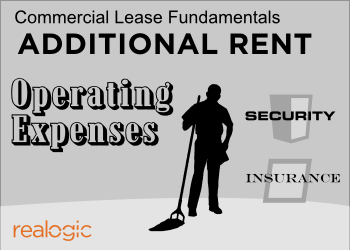 In this post, we have arrived at the topic of Operating Expenses, a component of additional rent typically paid by each tenant on a pro rata share basis. Most other items of additional rent, such as percentage rent, late fees, CPI and Porters Wage adjustments are paid independent of a tenant’s proportionate share.
In this post, we have arrived at the topic of Operating Expenses, a component of additional rent typically paid by each tenant on a pro rata share basis. Most other items of additional rent, such as percentage rent, late fees, CPI and Porters Wage adjustments are paid independent of a tenant’s proportionate share.
Operating Expenses can vary from building to building but can be defined in principle as Landlord costs in running a building or series of buildings that are passed on to those who actually occupy the building. Operating expenses may combine any number of items including some of these common items:
Common Operating Expense Items
- Utilities (Electric, Water, Heat)
- Insurance
- Maintenance and Repairs
- Janitorial Services and Supplies
- Building Security
- Landscaping / Snow Removal
- Management and Association Fees
- Amortization of capital improvements (with restrictions)
- Marketing Fee (for Retail)
How a Landlord Determines Operating Expenses
Landlords typically prepare an annual budget estimating the expenses to be spent during the upcoming year (calendar or fiscal) to operate and maintain a building. These expenses are then applied to each tenant according to the terms of the lease.
After applying the terms of the lease against the budgeted expenses, the landlord will know how much needs to be collected from a tenant to cover that tenant’s share of the building expenses. These collections are usually made monthly as part of the tenant’s rent payment.
Within a short period of time at the end of each year, the landlord will determine its actual operating expenses for the past year. The landlord will take this final number and subtract from it the “deposits” the tenant has made toward these final expenses during the year. The result will either be a credit due to the tenant when final expenses are less than “deposited,” or the tenant will owe an additional amount because the final expenses were higher than what was “deposited”.
This is a very simplistic explanation of the process and multiple variations exist to how a landlord and tenant handle their reimbursements but, generally, these are the basic mechanics.
Operating Expense LLClusions and Exclusions
Every lease will explain what items make up Operating Expenses. Often it is very clear, like a lease including language such as,“Operating Expenses means all expenses to operate and maintain the Building . . . and include the following: . . .” with a section following that lists the included items.
Sometimes the language can be vague but all leases have a section providing the included expenses and many provide excluded expenses as well. The first question the reader needs to answer is: are real estate taxes included in operating expenses or are they calculated separately? Combining real estate taxes with operating expenses when they should be separate can result in a loss of income for landlord in a “Gross” lease.
Other items that may be pulled out of operating expenses and calculated separately include management fees and utilities.
Sometimes a lease may specifically exclude an item but not bill it separately. Most of these contain an element of common sense and fairness. For example, a lease would state that the landlord cannot include tenant improvement costs or commissions in the operating expenses of the building. That is because when quoting a lease, the landlord recoups these costs as part of the quoted rental rates. These costs should not be covered by other building tenants.
In contrast, some items are truly unique to exclude. These can include any type of expense from janitorial costs, security costs or elevator expenses. These exclusions are rarely seen but are very important to watch for and make note of. They most often occur in leases for larger tenants who have more negotiating power.
Attached to the end of this post is a long list of standard operating expense exclusions. It is commonly understood in the industry that these items are not components of Operating Expenses passed on to tenants. It is usually not required that these items be noted in detail and any excluded item beyond the scope of this list should be noted and, if recognized before lease execution, negotiated.
That’s it for today’s blog post. I hope this article helps explain the basic mechanics of Operating Expenses for Commercial Real Estate Leases. Check back next Wednesday when we’ll delve into caps on increases in operating expenses and the commonly misunderstood concept of Gross Up.